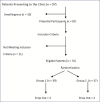Monochromatic Infrared Photo Energy Versus Low Level Laser Therapy in Chronic Low Back Pain
- PMID: 26705460
- PMCID: PMC4688382
- DOI: 10.15171/jlms.2015.11
Monochromatic Infrared Photo Energy Versus Low Level Laser Therapy in Chronic Low Back Pain
Abstract
Introduction: Low back pain (LBP) is the most common musculoskeletal disease. Monochromatic infrared photo energy (MIPE) and low level laser therapy (LLLT) are light modalities used to reduce pain and increase blood flow. The aim of this study was to compare the effects of the MIPE and LLLT in reducing functional disability and pain as well as improving lumbar range of motion (ROM) in patients with chronic LBP.
Methods: Seventy participants with LBP completed the program and were randomly assigned into 2 groups. Group 1 (n = 35) received MIPE and therapeutic exercises. Group 2 (n = 35) received LLLT and therapeutic exercises. Both groups received 2 visits per week for 6 weeks. Outcome measures were functional rating index (FRI), visual analogue scale (VAS) and modified-modified Schober test at baseline and after 6 weeks.
Results: There were statistically significant improvements in functional disability, pain and lumbar ROM (P < .05) in each group. However, no significant differences were recorded between the groups (P > .05).
Conclusion: Therefore, MIPE and LLLT may play a role in treating chronic LBP and there are no differences between the two modalities in improving functional disability, pain and lumbar ROM in patients with chronic LBP.
Keywords: Back pain; Chronic; Light; Low level laser therapy; Monochromatic; Pain; low.
Similar articles
-
Monochromatic Infrared Photo Energy versus Low Level Laser Therapy in Patients with Knee Osteoarthritis.J Lasers Med Sci. 2014 Fall;5(4):176-82. J Lasers Med Sci. 2014. PMID: 25653818 Free PMC article.
-
Is low-level laser therapy effective in acute or chronic low back pain?Clin Rheumatol. 2010 Aug;29(8):905-10. doi: 10.1007/s10067-010-1460-0. Epub 2010 Apr 23. Clin Rheumatol. 2010. PMID: 20414695 Clinical Trial.
-
Effects of Mulligan Mobilization and Low-Level Laser Therapy on Physical Disability, Pain, and Range of Motion in Patients with Chronic Low Back Pain: A Pilot Randomized Controlled Trial.Healthcare (Basel). 2020 Jul 29;8(3):237. doi: 10.3390/healthcare8030237. Healthcare (Basel). 2020. PMID: 32751064 Free PMC article.
-
Adjunctive Approach to Therapeutic Laser and Exercise Therapies in Alleviating Pain and Disability in Patients with Low Back Pain: A Systematic Review.J Lifestyle Med. 2024 Aug 31;14(2):69-79. doi: 10.15280/jlm.2024.14.2.69. J Lifestyle Med. 2024. PMID: 39280939 Free PMC article. Review.
-
Therapeutic ultrasound for chronic low back pain.Cochrane Database Syst Rev. 2020 Jul 5;7(7):CD009169. doi: 10.1002/14651858.CD009169.pub3. Cochrane Database Syst Rev. 2020. PMID: 32623724 Free PMC article.
Cited by
-
Use of Integrative Medicine in the United States Military Health System.Evid Based Complement Alternat Med. 2017;2017:9529257. doi: 10.1155/2017/9529257. Epub 2017 Jun 13. Evid Based Complement Alternat Med. 2017. PMID: 28690665 Free PMC article. Review.
-
Infrared Radiation in the Management of Musculoskeletal Conditions and Chronic Pain: A Systematic Review.Eur J Investig Health Psychol Educ. 2022 Mar 14;12(3):334-343. doi: 10.3390/ejihpe12030024. Eur J Investig Health Psychol Educ. 2022. PMID: 35323210 Free PMC article. Review.
-
Protective effect of Photobiomodulation Therapy and Bone Marrow Stromal Stem Cells Conditioned Media on Pheochromocytoma Cell Line 12 Against Oxidative Stress Induced by Hydrogen Peroxide.J Lasers Med Sci. 2019 Summer;10(3):163-170. doi: 10.15171/jlms.2019.26. Epub 2019 Jul 6. J Lasers Med Sci. 2019. PMID: 31749940 Free PMC article.
-
Photobiomodulation combination therapy as a new insight in neurological disorders: a comprehensive systematic review.BMC Neurol. 2024 Mar 19;24(1):101. doi: 10.1186/s12883-024-03593-4. BMC Neurol. 2024. PMID: 38504162 Free PMC article.
-
Effect of infrared belt and hot water bag on labor pain intensity among primiparous: a randomized controlled trial.BMC Pregnancy Childbirth. 2023 Jun 1;23(1):405. doi: 10.1186/s12884-023-05689-0. BMC Pregnancy Childbirth. 2023. PMID: 37264341 Free PMC article. Clinical Trial.
References
-
- Murtezani A, Hundozi H, Orovcanec N, Sllamniku S, Osmani T. A comparison of high intensity aerobic exercise and passive modalities for the treatment of workers with chronic low back pain: a randomized, controlled trial. Eur J Phys Rehabil Med. 2011;47(3):359–366. - PubMed
LinkOut - more resources
Full Text Sources
Other Literature Sources
Miscellaneous

